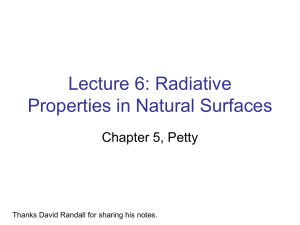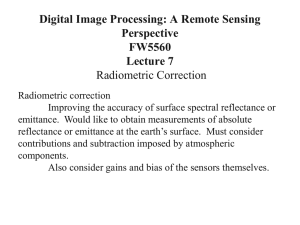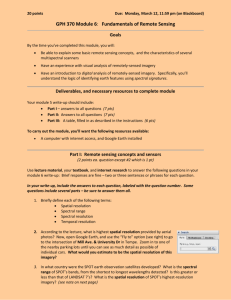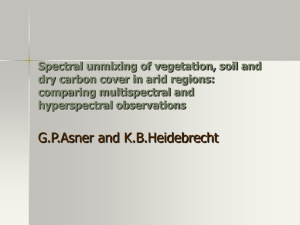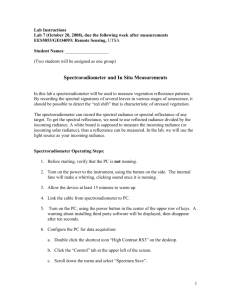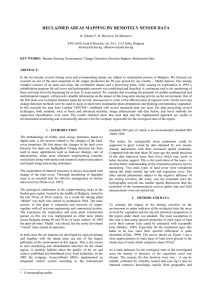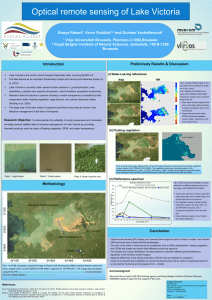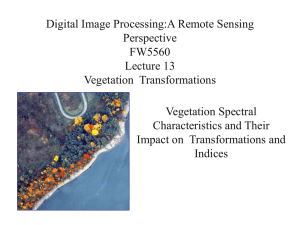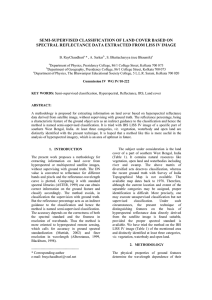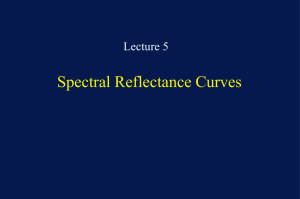THE RED EDGE: DETECTING EXTRATERRESTRIAL
advertisement
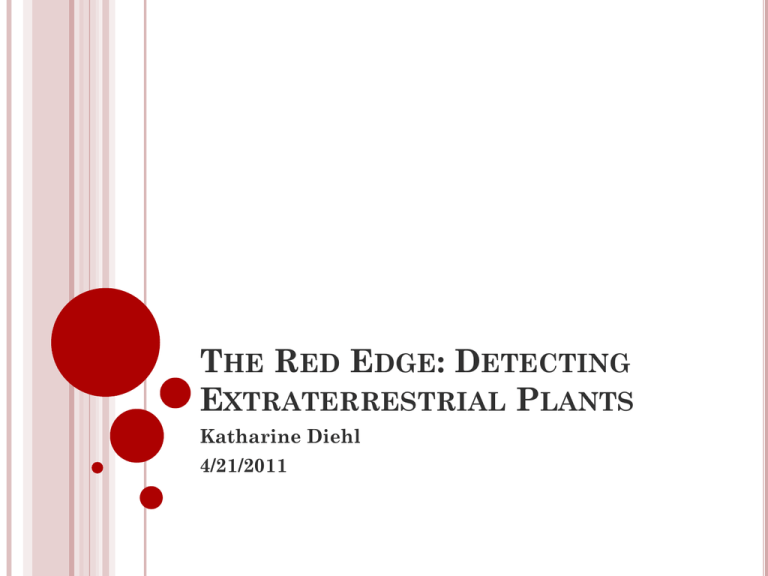
THE RED EDGE: DETECTING EXTRATERRESTRIAL PLANTS Katharine Diehl 4/21/2011 SPECTROSCOPIC BIOSIGNATURES Atmospheric biosignature: H2O, O2, O3, CH4 Potential surface biosignatures: the red edge of Earth’s vegetation distinct bidirectional reflectance distribution function (BRDF) of trees BRDF = how light is reflected off opaque surfaces WHAT IS THE RED EDGE? A strong rise in reflectivity around 700 nm Characteristic of land-based chlorophyllproducing plants Due to the strong reflectivity/transmitt ance of the leaf structure and the strong absorption of chlorophyll and Fig 1. Reflection spectrum of a deciduous leaf WHY DO PLANTS LOOK GREEN? Fig 2. Reflectance/Transmittance (%) of a young aspen leaf Green Near- IR USING THE RED EDGE ON EARTH Analyze vegetation type and age/health of crops and forests Plants with high chlorophyll and high Leaf Area Index (LAI): red edge shifts toward longer wavelengths Plants with low chlorophyll and low LAI: red edge shifts toward shorter wavelengths EXAMPLE: STUDY OF FOREST IN EAST ANGLIA Fig 3. Scatter plot of vegetation species using the Linear Interpolation Method to calculated red edge position values Fig 4. Scatter plot of vegetation based on mean red edge position values for the Linear method WHY DOES THE RED EDGE EXIST? Fig 5. Vegetation reflects/transmits almost all incident radiation in this near IR region WHY DOES THE RED EDGE EXIST? Two Theories Plants would overheat (Thermal regulation argument of Gates and Benedict) The large spaces in leaves aid in gas exchange and increase absorption at photosynthetically active wavelengths (Konrad and DeLucia) No one knows for sure, but the first theory is unlikely based on our beliefs about evolution EARTH’S RED EDGE- FIRST DETECTION Sagan and coworkers Galileo spacecraft was used during a fly-by of Earth in 1990 Low-res spectra of several different areas of Earth Found atmospheric biosignature and the red edge surface biosignature Vegetated areas: increase in reflectance by a factor of 2.5 between 670-760 nm Galileo Orbiter USING EARTHSHINE TO STUDY THE RED EDGE Light directly from sun Earthshine Earthshine = sunlight scattered by Earth toward the Moon and then back to Earth Allows viewing of Earth’s spatially integrated spectrum Woolf and coworkers detected a red edge of 410% around 700 nm After removal of atmospheric absorption bands of O2 and H2O FACTORS AFFECTING DETECTION OF THE RED EDGE BY A SPACE TELESCOPE Factors Atmospheric composition Large vegetation-less areas Cloud cover Anisotropic scattering by the leaves Soil characteristics Resolution of spectral data available One solution: Take a time series of data at different spectral bands ANALYZING EARTHSHINE TO DETECT THE RED EDGE Lots of vegetation Almost entirely ocean Fig 6. Earthshine flux spectra from telescope in Feb 2002 CAN THE RED EDGE BE USED TO DETECT LIFE ON EXTRASOLAR PLANETS? Would light-harvesting organisms on other planets use photosynthesis as we know it? Likely that some form of it would exist, but also likely that it wouldn’t be identical to what we know Would such organisms on other planets have similar spectral properties to vegetation? Sharp spectral features but at different wavelengths than Earth plants Would we be able to see the spectral features? Aquatic microorganisms and high opacity of H2O Other factors discussed previously If we saw the such spectral features, how would we know they came from plants and not minerals Next slide! FALSE-POSITIVE MINERAL REFLECTANCE Semiconductor crystals: scatter photons with insufficient energy to jump band gap Steep reflectance in visible and near-IR Shape and size of crystals affect the semiconducting properties unlikely to find large crystals on the surface of a planet like those in our solar system Fig 7. Reflectance of sulfur and cinnabar FALSE-POSITIVE MINERAL REFLECTANCE Difficult to identify mineral with reflectance Near and mid-IR absorption features Atmospheric composition (e.g. presence of O2) The red edge wavelength doesn’t correspond to that of any known mineral Cinnabar (HgS) CONCLUSIONS Weak red edge signature has been identified in Earthshine measurements Time series spectra of an exoplanet would likely be necessary Looking for a “red edge” at other wavelengths Could be difficult to prove that plant life is present with red edge alone Evaluation of reflectance data in light of other spectral data obtained Other methods of detecting tree-like vegetation REFERENCES BRDF Paper Good Review Doughty and Wolf. Astrobiology (2010), 10 (9), 869-79. Fujii et al. The Astrophysical Journal (2010), 715, 866-80 Seager et al. Astrobiology (2005), 5 (3), 372-90. Shafri et al. Am. J. Appl. Sci. (2006), 3 (6), 1864-71. Wikipedia: (http://en.wikipedia.org/wiki/Main_P age)


